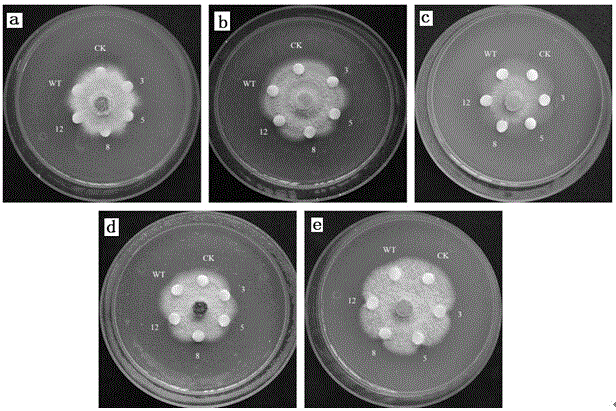Panax notoginseng antimicrobial peptide gene PnSN1 and application thereof
An antimicrobial peptide and gene technology, applied in Panax notoginseng antimicrobial peptide gene PnSN1 and its application fields, can solve the problems of easily inducing diseases and insect pests, affecting the yield and quality of Panax notoginseng raw medicinal materials, and achieve reduction of environmental pollution, broad market application prospects, The effect of shortening the breeding cycle
- Summary
- Abstract
- Description
- Claims
- Application Information
AI Technical Summary
Problems solved by technology
Method used
Image
Examples
Embodiment 1
[0022] Example 1: PnSN1 full-length cDNA cloning and sequence analysis
[0023] The root of Panax notoginseng was inoculated with Fusarium solani rot, the total RNA was extracted from the root 12 hours after inoculation, the treated root of Panax notoginseng was ground into powder with liquid nitrogen, then transferred into a centrifuge tube, and extracted by guanidine isothiocyanate method total RNA. The reverse transcriptase M-MLV (promega) was used to synthesize the first strand of cDNA using total RNA as a template. The reaction system and operation process were as follows: take 5 μg total RNA, add 50 ng oligo (dT), 2 μL dNTP Mix (2.5 mM Each), the reaction volume was made up to 14.5 μL with DEPC water; after mixing, heated and denatured at 70°C for 5 min, then rapidly cooled on ice for 5 min, then added 4 μL 5×First-stand buffer, 0.5 μL RNasin ( 200U), 1 μL M-MLV (200U), mix well and centrifuge briefly, incubate at 42°C for 1.5 h, take it out and heat at 70°C for 10 min ...
Embodiment 2
[0026] Embodiment 2: plant overexpression vector construction
[0027] The Escherichia coli plasmid pGEM-T-PnSN1 inserted into PnSN1 and the plant expression vector pCAMBIA2300S plasmid were extracted using the SanPrep column plasmid DNA mini-extraction kit (Shanghai Sangong), and 1 μL was used for agarose gel electrophoresis to detect the extracted Plasmid integrity and concentration. Restriction enzymes BamHI (TaKaRa) and Pst (TaKaRa) carried out double digestion of plasmids pGEM-T-PnSN1 and pCAMBIA2300S respectively (100 μL system). The reaction system and operation process were as follows: take 20 μL pGEM-T-Pnsnakin and pCAMBIA2300S plasmids respectively, and add 10 μL 10×K buffer, 4.5 μL BamHI, 5.5 μL Pst , 60 μL ddH 2 O, after mixing, centrifuge for a short time, and place at 37°C for overnight reaction. All digested products were subjected to agarose gel electrophoresis, and then the PnSN1 fragment and the large fragment of the pCAMBIA2300s vector were gel-recover...
Embodiment 3
[0030] Example 3: Plant genetic transformation mediated by Agrobacterium and screening of transgenic plants
[0031] The transgenic recipient in this experiment was tobacco (Nicotiana tabacum L.). Tobacco seeds were soaked in 75% alcohol for 30 s, washed with sterile water and washed with 0.1% HgCl 2 Soak for 8 minutes, then wash several times with sterile water, sow on 1 / 2 MS medium, culture in dark at 28°C for 5-8 days, transfer to light incubator after germination (25°C, 16 h / d light) , and then subculture once a month with MS medium.
[0032] Take out the preserved Agrobacterium LBA4404 strain containing the pCAMBIA2300S-PnSN1 plasmid from the -80°C refrigerator, take 20 μL and inoculate it into 5 mL of LB liquid medium containing 50 mg / L Km and 20 mg / L rifampicin, 28 Cultivate until the medium becomes turbid. Pipette 1 mL of turbid bacterial solution onto LB solid medium containing 50 mg / L Km, and incubate at 28°C for 48 h. Then scrape off an appropriate amount of Agr...
PUM
| Property | Measurement | Unit |
|---|---|---|
| molecular weight | aaaaa | aaaaa |
Abstract
Description
Claims
Application Information
 Login to View More
Login to View More - R&D
- Intellectual Property
- Life Sciences
- Materials
- Tech Scout
- Unparalleled Data Quality
- Higher Quality Content
- 60% Fewer Hallucinations
Browse by: Latest US Patents, China's latest patents, Technical Efficacy Thesaurus, Application Domain, Technology Topic, Popular Technical Reports.
© 2025 PatSnap. All rights reserved.Legal|Privacy policy|Modern Slavery Act Transparency Statement|Sitemap|About US| Contact US: help@patsnap.com



